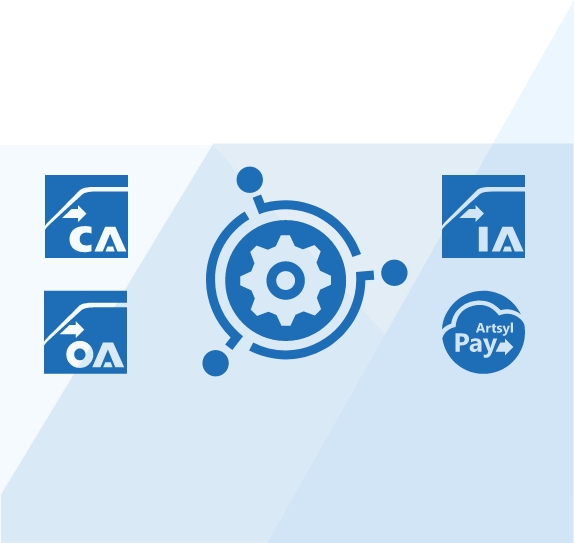If you own a business or work as a freelancer or consultant, issuing invoices is a common occurrence that’s just part of doing business. An invoice is a document that outlines the details of a product or service sold, along with the payment details.
A standard invoice acts as a bill for sales and is used to request payment from a customer. In this article, we’ll discuss everything you need to know about a standard invoice, why it’s important, and how to create one.

Revolutionize your invoice processing!
Dive into the future with InvoiceAction and transform your standard invoice management. From rapid data capture to seamless integration, it’s time to elevate efficiency and accuracy. Make the smart switch today, and let your business soar!
What is a Standard Invoice?
A standard invoice is a document issued by a seller or service provider to a buyer that outlines the details of a product or service sold, along with the payment details. It’s a formal request to a customer for payment of the goods and services provided.
Invoicing isn’t just a method of receiving and recording payments; it also helps establish an excellent professional relationship between the seller and the buyer. A standard invoice serves as proof of purchase or sale of products or services, which is essential in accounting for your business activities.
Invoice Automation Software
Related Videos
Standard Invoice Definition
A standard invoice is a formal document issued by a seller to a buyer, detailing the goods or services provided, their quantities, and agreed-upon prices. It serves as a request for payment and includes vital details such as the date of issue, due date, unique invoice number, seller and buyer’s contact information, tax amounts, any discounts, and the total amount due.
Standard invoices are commonly used in business transactions to establish a record of sale and are crucial for bookkeeping, accounting, and tax purposes.
Experience the gold standard in sales order processing! OrderAction brings you unrivaled capabilities to streamline, automate, and simplify your order processing. Unchain your team from manual drudgery and unlock unmatched productivity. Isn’t it time you stepped into the future?
Book a demo now
Components of a Standard Invoice
A standard invoice should include the seller and buyer details, including the name and address. The invoice should also have a unique invoice number, the date of issue, a description of the goods or services sold, the quantity sold, the price, and the total amount due. For your convenience, we have listed the typical components of a standard invoice:
- Header: The word «Invoice» should be prominently displayed at the top.
- Invoice Number: This is a unique identifier for each invoice, essential for record-keeping and reference.
- Invoice Date: Indicate when the invoice is issued.
- Due Date: The date by which the payment should be made by the buyer.
- Seller’s Details: Information about the seller including business name, address, contact number, and possibly the logo.
- Buyer’s Details: Information about the buyer or recipient including business or individual name, address, and contact number.
- Description of Goods/Services: Standard invoice should contain a detailed list of all items or services provided, including quantities, individual unit prices, and any applicable serial numbers or descriptions.
- Subtotal: The total amount for goods or services before any tax, discounts, or additional charges are applied.
- Taxes: Details and amounts of any applicable taxes (e.g., VAT, sales tax).
- Discounts: Any discounts or rebates that are subtracted from the subtotal.
- Shipping or Additional Fees: Any additional charges such as shipping, handling, or service fees.
- Total Amount Due: The comprehensive total the buyer is required to pay, factoring in all the previous elements.
- Payment Terms: Any standard invoice should include information on accepted payment methods (e.g., bank transfer, check, online payment) and any related instructions. It may also include details about penalties for late payments or benefits for early payments.
The footer might include additional contact details, banking information for transfers, or any other necessary regulatory or business-specific information. Also, leave space for any additional information the seller wants to provide, which could include return policies, gratitude notes, or further explanations of specific charges.
These components ensure that both the buyer and seller have a clear understanding of the transaction’s terms and serve as a legally binding record of the sale.
Creating a standard invoice can be done through various methods, including in-person, through email, or online invoicing software. The most important thing to ensure is that the invoice contains all the relevant information about the transaction, is clear and concise, and is payable in a way that’s convenient for the client.
Time is money – save both with InvoiceAction! No more chasing down errors or wading through paperwork. Supercharge your standard invoice processing with cutting-edge technology designed for precision and speed. Make every second count!
Book a demo now
Using Standard Invoices In Business
Standard invoices are a common sight in the business world. They are used to request payment for goods or services rendered. Here are some real-life examples of situations where standard invoices are typically used:
- A graphic designer who has completed a logo design for a client sends a standard invoice detailing the hours spent and the agreed-upon rate.
- After supplying a local store with handcrafted jewelry, a supplier sends an invoice for the total amount of items delivered.
- A management consultant, after completing a month-long project for a corporate client, sends an invoice for the hours worked based on a previously agreed hourly rate.
- An online retailer sends an invoice with the delivered package, showing the purchased items, their prices, any shipping fees, and the total amount owed.
- At the end of the month, a water utility company sends households a standard invoice for the amount of water consumed.
- A plumber who has fixed a leaky faucet at a residence sends an invoice detailing the labor cost and the price of any replaced parts.
- A law firm representing a client in a civil case sends a monthly invoice showing the hours worked by each attorney, paralegal, and other staff members.
- A landlord sends a monthly rental invoice to a tenant for a leased commercial space.
- A company offering monthly subscription boxes sends an invoice every month to its subscribers, detailing the cost of the box and any additional charges.
- After a patient visits a clinic, the healthcare provider sends an invoice detailing the consultations, tests, and any medications or treatments provided.
In all these scenarios, the standard invoice typically includes essential components like the name and address of the seller and buyer, date of the invoice, description of the goods/services, total amount due, payment terms, and more.
Ride the wave of intelligent automation! Drown out inefficiencies with Artsyl docAlpha’s power-packed features for financial automation. Navigate effortlessly through every invoice, ensuring every detail is captured and every process is optimized. Dive in and make waves in your industry!
Book a demo now
How Standard Invoice Compares to Other Types of Invoices
Invoices come in various forms, tailored to specific business scenarios. The standard invoice is the most common, but let’s compare it to other types of invoices:
Standard Invoice vs. Proforma Invoice
- Standard Invoice: A formal request for payment after goods or services have been delivered or completed.
- Proforma Invoice: An initial document sent to buyers in advance of a shipment or delivery of goods, providing a preview of the goods’ costs. It’s not an official request for payment.
Standard Invoice vs. Credit Invoice:
- Standard Invoice: Asks for payment from the buyer.
- Credit Invoice: Also known as a «credit memo», this details a credit owed to the buyer, usually due to returns, errors, or overpayments. It effectively reduces the amount the buyer owes.
Standard Invoice vs. Debit Invoice
- Standard Invoice: Details the amount the buyer owes.
- Debit Invoice: Issued to increase the amount a buyer owes, typically because of an undercharge or additional charges coming up after the initial invoice.
Standard Invoice vs. Interim Invoice
- Standard Invoice: Charges for goods or services provided, typically sent after the completion of a job.
- Interim Invoice: Breaks down the billing of a lengthy project into several payments over time. Common in larger projects where costs accumulate.
Standard Invoice vs. Recurring Invoice
- Standard Invoice: Typically a one-time billing for services rendered or goods delivered.
- Recurring Invoice: Sent at regular intervals (e.g., monthly) for ongoing services, such as subscriptions or retainers.
Standard Invoice vs. Timesheet Invoice
- Standard Invoice: Based on products delivered or fixed services rendered.
- Timesheet Invoice: Based on hours worked, commonly used by consultants or freelancers.
Standard Invoice vs. Commercial Invoice
- Standard Invoice: Used for general business-to-business transactions.
- Commercial Invoice: Specifically used for customs in the shipping of goods across international borders. Contains details required for customs clearance, like country of origin and Harmonized System codes.
Standard Invoice vs. Value-Based Invoice
- Standard Invoice: Charges based on predetermined prices or rates for products or services.
- Value-Based Invoice: Charges based on the perceived value of results delivered, rather than just the service itself.
In essence, while the standard invoice is a foundational document used across industries to request payment, other invoice types cater to specific scenarios or transaction types. The right choice of invoice can ensure clarity in communication and smoother financial transactions between businesses and their clients.
Connect, integrate, and elevate with InvoiceAction! Bridging gaps in your invoice management has never been easier. Seamlessly integrate with your existing systems and witness the harmony of automation. Step up, sync up, and set new benchmarks!
Book a demo now
Why InvoiceAction Is the Best Way to Process a Standard Invoice
Artsyl InvoiceAction stands out as an optimal solution for processing standard invoices for several reasons.
Dynamic Workflows
InvoiceAction allows businesses to create custom workflows that match their internal invoice processing and approval routines. This ensures that the software adapts to the business and not the other way around.
Efficiency and Speed
Using intelligent process automation, InvoiceAction drastically reduces the time traditionally taken to process invoices manually. This allows businesses to handle larger volumes of invoices without increasing overheads.
Data Accuracy
With its advanced, AI-powered optical character recognition (OCR) and machine learning capabilities, the software ensures that the data extracted from invoices is accurate, minimizing human errors.
Seamless Integration
Artsyl InvoiceAction can easily integrate with leading ERP systems. This ensures a smooth flow of data between invoicing and accounting systems without any hiccups.
Automated Data Capture
Instead of manually keying in data, InvoiceAction automatically captures all necessary invoice components from a variety of formats and sources.
Audit Trail
The software maintains a transparent audit trail for every invoice, ensuring that businesses can track each step of the invoice processing journey, which is essential for compliance and accountability.
Exception Handling
When anomalies or exceptions arise, InvoiceAction automatically flags them and routes the invoice to the appropriate personnel for resolution. This ensures that discrepancies are handled promptly.
Cost Reduction
By automating many of the labor-intensive tasks associated with invoice processing, businesses can realize significant cost savings.
Enhanced Cash Flow Management
Faster and accurate invoice processing means quicker payments and better cash flow management. Companies can also take advantage of early payment discounts when due dates are accurately tracked.
Given these capabilities, Artsyl InvoiceAction is positioned as an ideal solution for companies looking to modernize their invoice processing procedures, reduce errors, improve efficiency, and ultimately save on costs.
Final Thoughts: The Many Uses of a Standard Invoice
Invoicing is a critical part of running a business or providing professional services. A standard invoice is a formal request that establishes a professional relationship between the seller and buyer, and serves as proof of the transaction. It’s important to ensure all the relevant details are included in the invoice, such as the payment terms, due date, and descriptions of the goods or services sold.
By following the tips for effective invoicing, you can ensure you receive your payment timely and avoid any future disputes. Go ahead and create an effective standard invoice that will help your business grow!
Spot-on accuracy meets speed! Say goodbye to costly mistakes. With Artsyl docAlpha, every standard invoice is processed with laser-like precision, ensuring you capture every detail. Experience the confluence of speed and accuracy, and drive your business to new heights!
Book a demo now





 Your Guide to Commercial Invoices
Your Guide to Commercial Invoices Interim Invoice: What Is It?
Interim Invoice: What Is It? Self-Billing Invoice: What Is It?
Self-Billing Invoice: What Is It? Supplier Invoice Management Software
Supplier Invoice Management Software How to Build an Automated Invoice Processing Workflow
How to Build an Automated Invoice Processing Workflow Invoice vs. a Quotation - What’s the Difference?
Invoice vs. a Quotation - What’s the Difference?